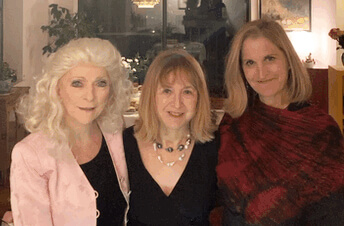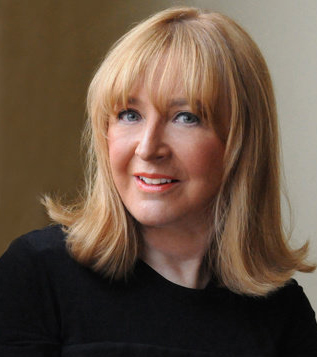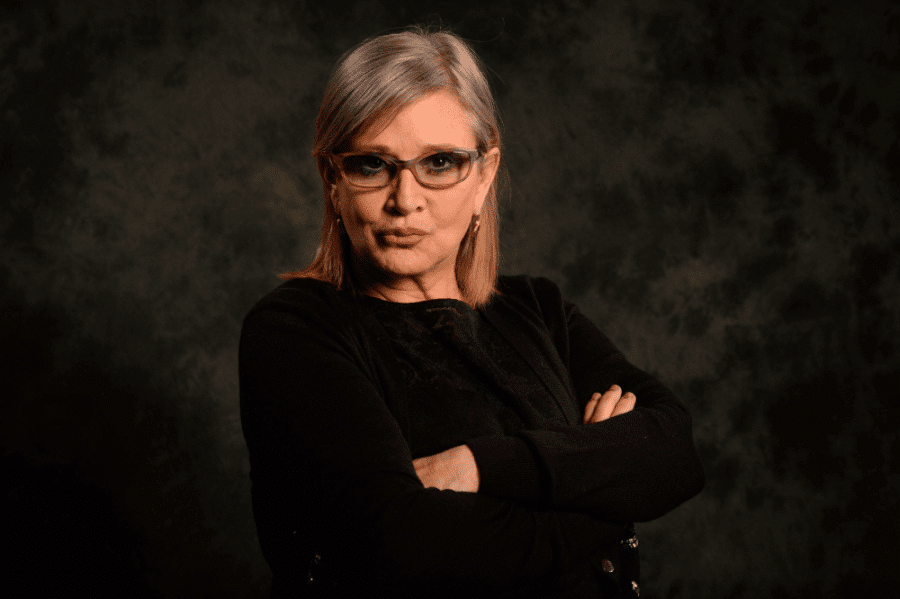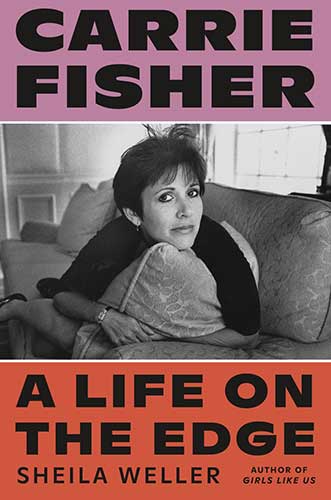A year ago, we ran this excerpt from Sheila Weller’s book, Carrie Fisher: A Life on the Edge. To celebrate the publication , NextTribe co-founder Jeannie Ralston threw a party in New York for Sheila, a NextTribe contributing editor, attended by many of Sheila’s friends, including Judy Collins (shown below with Sheila, center, and Jeannie).
Sheila’s book is now out in paperback and we are re-running the story, with a new offer that highlights Sheila’s wonderful examination of an intriguing and iconic life and her commitment to promoting and connecting women in this 45-plus age group. The first 10 women who sign up as new NextTribe members will receive a free copy of Sheila’s Carrie Fisher biography. We hope to have you as part of the Tribe and to be able to send you this fabulous gift in thanks.

***
In the early spring of 1985 Carrie Fisher suffered an overdose of tranquilizers and was rushed to Cedars-Sinai Medical Center by two friends, one a doctor, David Kipper, and one a writer, Carol Caldwell; they pumped her stomach and saved her life. Her brush with death led to subsequent time spent in rehab—and an eleven-month-long hewing to Alcoholics Anonymous sobriety. During this time she decided to write a book inspired by the incident – and by her complex relationship with her mother, Debbie Reynolds.
She named that book Postcards From the Edge.
Carrie opened the book with the line “Maybe I shouldn’t have given the guy who pumped my stomach my phone number, but who cares?” She ended it with a letter to that same lifesaving doctor, concluding with witty melancholy: “That night in the emergency room, do you recall if I threw up something I needed? . . . I distinctly feel as though I’m missing something.” Pause. “But then, I always have.”
Carrie used her real post-rehab experiences in the book. She transformed her desperation work on the director Penelope Spheeris low-budget undercover-cop movie Hollywood Vice Squad into her character Suzanne Vale’s desperation work on a low-budget undercover-cop film called The Kitchen Sink. As in Carrie’s real life, Suzanne Vale takes the cheesy role because she thought that, given her drug history, she’d never work again.
The Glib and The Profound
Readers would come to know Carrie, the glib and the profound in its own lively mix. They would get the cynical social critic: “You can’t find any true closeness in Hollywood because everybody does fake closeness so well.” And the standard-issue neurotic: “My problem is, I only know how to need needy people . . . Somebody . . . could be wearing a sign, ‘I have no problems, you can believe me,’ and I wouldn’t even see them.” The soon-to-be-very-famous over-sharer: “But deep down—and you don’t get too far deep down with me, because I’ve thrust all the deep down right up to the surface.” The sociologist: “I guess that’s how guys are thoughtful in the 80s—they accompany girls to their abortions.” She expressed many women’s paradoxical yearnings: “She had finally decided she wanted stimulating that very subtly became calming—a holocaust that became a haven.” She infused her grandmother Maxene’s tough pragmatism (hewed from a previous impoverished life in El Paso) into Hollywood Suzanne’s complication, as if preaching to herself: “Just pick someone and make it work . . . I’ve stayed with your grandfather now for 50-odd years. I don’t like him but I picked him.” In Maxene’s generation, “We make a choice and we stick with it and I think you could learn something from that.”
The first 10 women to join NextTribe as new members will receive free copies of Sheila Weller’s Carrie Fisher biography. Join here.
There’s Carrie/Suzanne owning her stubborn pathology. A man says, “‘I like to feel like I could perform surgery at any given moment.’ ‘That’s interesting,’ said Suzanne. ‘My goal was to feel I could go into surgery at any given moment.’” Some of this is Carrie-shtick, but it’s winning and smart and not hollow. The book ends with Suzanne Vale being driven to the hospital by the decent Jesse for treatment after burning her hand while making waffles. “I should open up a house account here,” she says of the venue she was taken to after her overdose. Jesse admits, “They should at least give you a quantity discount.” Suzanne Vale amuses us while her angst feels genuine. We envy her blasé worldliness, but the pain that’s its price makes it safe not to be jealous of her.
The book’s debut was helped by felicitous rave blurbs from Carrie’s friends. “Carrie’s book is savagely funny and savagely revealing. It makes Moby Dick look like a big, fat, dumb book,” said Steve Martin. Candice Bergen said, “This is a remarkable first novel. In fact, it is a remarkable second novel.”
The Voice of a Real Person
There was excitement at Simon & Schuster during the copyediting of Postcards, gearing up to its August 1987 publication. “It was such a unique book,” said Susan Kamil, who was the editor as the book neared completion. “The intelligence, the transparency—the voice was the voice of a real person. It was the beginning of Carrie Fisher being a centrifugal force,” she says. “The combination of celebrity and honesty was so new.” Indeed, it would not be until years later that female Hollywood insiders wrote tartly about the industry: Julia Phillips’s You’ll Never Eat Lunch in This Town Again came out in 1991; Lynda Obst’s Hello, He Lied, in 1996; Nancy Griffin and Kim Masters’s Hit and Run, in 1996. And, for that matter, Peter Biskind’s Easy Riders, Raging Bulls wasn’t published until 1998.
“Her comebacks and her wit were machine-gun fast,” Kamil continued. “Unlike many celebrities in Hollywood, she gravitated to the more intellectual people, the brain-driven. And I remember her tremendous generosity. She told me she had a friend, Bruce Wagner—the brilliant Bruce Wagner!—and she told me about his privately published book Force Majeure.” Carrie gave the book to Susan. Simon & Schuster ended up publishing it, Kamil reports. In its major-publishing-house version, it quickly garnered comparisons to Nathanael West and F. Scott Fitzgerald. Wagner has many times expressed his gratitude to Carrie, not just for the introduction to S&S, but for her enormous friendship. “She’s tremendously forgiving,” Wagner has privately said. “I have not been there for her in many ways that she’s been there for me, not by choice but out of my own personal weakness,” he added.
Read More: Joni Mitchell: 3 Reasons Why She Matters So Much to Us
Rave Reviews
The rave reviews for Postcards were kicked off by the novelist, memoirist, and third-generation Los Angeles native Carolyn See, who provided it with one of the first many happily stunned reviews. See seemed to be thinking out loud as she expressed her intrigue with and lack of preparation for Carrie the writer:
Everyone knows Carrie Fisher for her portrait of Princess Leia in the film “Star Wars,” and all those other movies. And everyone knows her royal Hollywood lineage: the daughter of Eddie Fisher and actress Debbie Reynolds. And no doubt lots of readers will buy “Postcards From the Edge” because of those facts, and all the promotional fallout that comes from them.
But a couple of things come to mind when you get about 50 pages into “Postcards From the Edge.” You wonder, thinking back, why Carrie Fisher—why she didn’t grab your mind as you watched the screen, the way her mother did. And it occurs to you, Carrie Fisher’s heart might not have been in it. You deduce this fact because her heart appears to be in this novel and in the writing process. This book is so much better than you think it’s going to be! It’s intelligent, original, focused, insightful, very interesting to read.
In another paragraph See wrote, “This is not an inspirational novel, but something on the order of a tough look at reality; a ‘serious’ piece of work.”
The Washington Post called Postcards “a cult classic . . . a wonderfully funny, brash, and biting novel, the most startling literary debut since Jay McInerney’s Bright Lights, Big City.” Time compared Carrie’s Suzanne Vale to Holden Caulfield. The high-barred Kirkus had issues with it (she “slips into a meandering, poor-me account of Suzanne’s spoiled but troubled adjustment to post-detox life”) but ultimately called the novel “dryly comic . . . often exhilarating.” From the San Jose Mercury News: “surprising, hilarious, breathtaking, a wry and witty commentary on life in the fast lanes of Freewayland.”
In general, there was a sense of a newly revealed identity, once hidden and now excitedly discovered, and that it was real. There would come comparisons to Erica Jong, Nora Ephron, and Joan Didion, and to Bret Easton Ellis, Hunter S. Thompson, her role model Dorothy Parker, David Sedaris, Augusten Burroughs, and Martin Amis.
The book launch took place in New York, with a party at the S&S executive Joni Evans’s apartment. During a pre-party interview with The New York Times’s Michael Gross, a merry, antic Carrie “bounced into the bathroom to fuss with her hair for the fourth time in ten minutes” and did not fail to give great, honest Carrie quotations—about the allure of drugs and her late friend John Belushi, about skipping the snide for the wryly confessional. It was Eddie’s fifty-ninth birthday, and he was attending the party that night. Ever the dutiful daughter, she had bought him a present: a jacket and pants. Gross left the interview “thinking she was hysterically funny and I left there thinking I had just met somebody extraordinary,” Gross says.

Sheila Weller, author of the new Carrie Fisher biography and a NextTribe contributing editor.
Far, Far Away From Star Wars
Postcards eventually became a bestseller, and feature interviews with Carrie brought her distinctive personality and wit to a public that had formerly thought of her merely as the Star Wars heroine. “She is an interviewer’s delight: Everything is out on the table. No secrets. The whole shebang,” Stephanie Mansfield excitedly told her Washington Post readers. There’s Carrie’s quirky taste in food. French food “is not food. It’s like a picture of food,” declared Carrie, who always had a yen for Mexican. Mansfield called Carrie what her friends and the cognoscenti have known—“small and smart and saucy . . . a girl’s girl. You want to go shopping with her. You want to double-date with her . . . even though her new book . . . is all about how she . . . [got] her stomach pumped.”
“Most children wait for their parents to die before writing such a book,” Mansfield noted. “Boy, when they die,” Carrie lobbed back, “I’m gonna come out with a sitcom.”
When interviewer and interviewee get to the Mexican restaurant and two tables are offered and rejected until a third is chosen, she quips to the waiter, “This is the most moving, moving experience.”
Mansfield wrote, “She worries that therapy is her only serious relationship . . . About a year ago, after therapy by men, she found a woman shrink.” To which Carrie riposted, “Next, I’m going to go for an 11-year-old child.” Who else talked like that?
Her earlier print interviews had a hint of who Carrie was, but now her unique personality was in full force. Carrie embarked on an eight-city tour for Postcards’s publication, and Gary Springer—son of the well-known publicist John Springer (who had had Debbie and Richard Burton among his many clients)—accompanied her as a publicist/minder. “She brought her Bumble and Bumble hairdresser with her because she felt the only way she could feel different at every event was to have a different hairstyle,” Springer recalls. Because of the daily washing and setting, she had T-shirts printed bald by frisco and distributed them to her team. But in the behind-the-scenes portion of the tour, Carrie’s vulnerability, which had been evident throughout her wry, wisecracking life, was very much in the fore.
Carrie had so much stage fright before every appearance that Springer would spend “the entire day or morning before the event in the hotel bathroom with her. I was sitting on the edge of the tub while she was on the floor, wrapped around the toilet: throwing up. She was so nervous. But then she would go out to the event and she was absolutely delightful—buoyant and energetic, smiling and bubbly. And she wanted every event and presentation to be different than the previous day’s. And they were.”
A New Identity
From that point on, Carrie, at 31, had a new identity that would flourish over seven additional books and a self-written one-woman play. She thought of herself now not as an actress who wrote but as a writer who acted. Writing in a style she called “faction” (fact plus fiction), she recounted the details of her life with a searing, hilarious honesty that relieved other “imperfect” women and had a healing quality. Among other things, when she admitted her bipolar disorder and told the world, “I am mentally ill; I can say that,” she destigmatized the disorder throughout America. It was perhaps—or more than perhaps—what she did best.
After this success, acting—even as world-famous Princess Leia—would become and remain secondary.
Read More: Molly Ivins Documentary: A Maverick’s Moment On-Screen and in Spirit
***
EXCERPTED FROM CARRIE FISHER: A LIFE ON THE EDGE BY SHEILA WELLER. PUBLISHED BY SARAH CRICHTON BOOKS, AN IMPRINT OF FARRAR, STRAUS AND GIROUX, NOVEMBER 12, 2019. COPYRIGHT © 2019 BY SHEILA WELLER. ALL RIGHTS RESERVED.
Sheila Weller is the author of eight books (three of them New York Times Bestsellers), including Carrie Fisher: A Life on the Edge and Girls Like Us: Carole King, Joni Mitchell, Carly Simon—and the Journey of a Generation, which Billboard magazine recently named #19 of the best music books of all time. She has been writer of major features for Vanity Fair, a recent longtime senior contributing editor at Glamour, a has written for the New York Times Opinion, Styles and Book Review and for just about every women’s magazine in existence. She has won 10 major magazine awards.






















0 Comments